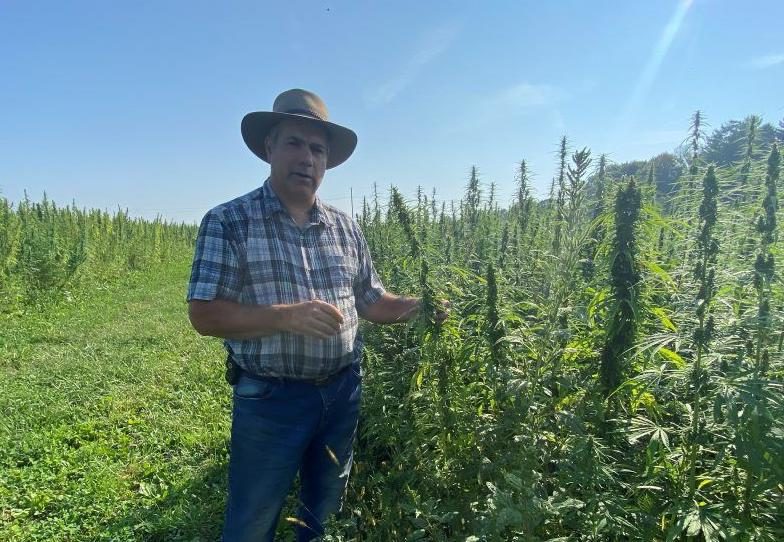Those of us who started using cover crops and no-till decades ago remember the challenges we faced using these innovative methods to grow corn, soybeans and small grains.
Choosing vigorous genetics and the correct cover crops, adjusting our planting equipment, and ironing out weed control options were all issues we had to deal with in getting those new growing paradigms figured out.
Fast forward to the present with hemp production, and it’s these same problems we have to deal with. The challenge is even greater in that hemp is a small seed, only planted a half inch deep, and most of the genetics are wimpy in regard to emergence. But I’ve persevered for the past three years and certainly have learned a good deal about how to successfully get both CBD and fiber-type hemp out of the ground while using cover crops and no-till.
Choosing the Correct Cover Crop
Cover crop species matters when it comes to hemp production. The field of fiber hemp that we used to create our hemp maze attraction had been planted in a mix containing cereal rye. A portion of the plot used a mix that included black oats, which is a winter oat that survives the cold.
The direct-seeded hemp sowed into the black oats mix grew unhindered, while what was planted in the cereal rye did not have as good emergence and was lethargic.
Upon observing this, I remembered what I’d been preaching for years. Cereal rye’s allelopathic effect is most prevalent in affecting the germination of small-seeded broadleaf plants, exactly what hemp is. Some things are learned by happenstance and not by intention.
I’ve also noted that hemp grows very well behind hairy vetch — both transplanted CBD varieties and direct-seeded fiber hemp. Now my cover crop mix of choice is based on using black oats and hairy vetch.
Weed Control
There are very few labeled herbicide options when it comes to weed control in hemp, although I know of several institutions that are testing them, including Penn State.
Relying on a cover crop for weed control is a rational approach, but it requires careful planning and execution.
A consistent stand is a given. Allowing it to grow as long as possible in the spring will provide additional suppression of weeds but makes it more difficult to plant into and get a good stand. Starting with a field that has a history of low weed pressure is your best bet.
Fine-Tuning Planting Equipment
Most planters and drills are designed to plant larger seeds at a depth or 1 inch or deeper. This presents quite a challenge with hemp in that it should only be planted a half inch deep.
Here’s what I’ve learned during hours of configuring and reconfiguring our 15-inch planter.
Use row cleaners aggressively in conjunction with a sharp coulter. Install canola seed tubes so the tiny seeds are directed into the shallow seed trench.
We mounted a Rebounder in addition to the Keeton seed firmers. Make sure the closing wheels are spaced correctly for shallow-planted seed. By the way, a good setup can also be used to plant into a green cover crop.
For a CBD-type hemp, a small seed plate will have to be used to singulate the seeds and plant at the proper low population. Even for higher rates of fiber hemp, the use of a single disk drill can be a challenge unless there is very little residue to cut through. Drills with coulters may be better. Set them similar to what you’d do to plant alfalfa or grass.
The Right Genetics
This may be the biggest frustration, particularly with CBD hemp. Most if not all CBD genetics are started in greenhouses and then transplanted in the fields. The best CBD varieties I’ve direct-seeded only had a germination of 60%. I’m working with a plant breeder to develop enhanced genetics to meet this need.Fortunately, fiber and seed hemp varieties are much better in that they have already been selected from a direct-seeding situation. Even so, pay attention to the germination listed on the seed tag, or better yet, do a germination test yourself to adjust to the desired emergence rate.
Understanding Fertility
All forms of hemp require fertility similar to pumpkins or tomatoes. Adjust applied inputs according to what the cover crop may provide and to the degree of soil health present in the field.
There is nothing better than your own personal experience in getting a successful hemp crop grown using cover crops and no-till. Understanding these basic tips will get you headed in the right direction.
Related Content:
One Farm’s Experience No-Tilling CBD Hemp: No-tiller David Groff from Cedar Meadow Farm in Holtwood, Pa., talks about the farm’s experience this year no-tilling hemp and the cover-crop mix and fertility plan they followed during the growing season.
[Podcast] Strategies for Getting Off the Starting Block with Cover Crops: Cover crop educator and Pennsylvania no-tiller Steve Groff talks about the mindset necessary to be successful in adopting cover crops in a no-till system.
[Video] 5 Mindsets that Successful Cover Croppers Have in Common: Pennsylvania no-tiller and internationally renowned cover crop coach Steve Groff shares the importance of looking to the future and trying new strategies in this presentation from the 2019 National Cover Crop Summit.





Post a comment
Report Abusive Comment